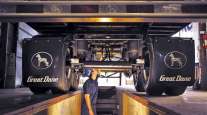Senior Reporter
November Trailer Orders Clear 42,000 Amid Surging Demand for Dry Vans

U.S. trailer orders jumped 15% in November, climbing past 42,000 and powered by surging demand for dry vans, ACT Research Co. reported.
Net orders reached 42,048. A year earlier they were 36,475, according to ACT.
Dry vans orders totaled 30,455, up 9% year-over-year. November was the second-best month ever for dry vans — trailing only October 2014, said Frank Maly, ACT’s director of commercial vehicle transportation analysis and research.
“Trailer orders were very robust. The biggest percent change was in reefers. They were over 5,200 units and up 21% year-over-year,” Maly said.
Also, cancellations are very low, he said. “Fleets are making their commitments and holding them.”
The research company FTR pegged net orders at 42,600 units.

Ake
“It’s a great month. There are good signs here,” said Don Ake, FTR’s vice president of commercial vehicles. “It is good news for the economy in 2018 that orders increased across the board.”
Trailer segments either showed significant increases or were already running high and delivered another good month, Ake said, “which means the increase was across all trailer makers.”
Those new orders will stabilize the backlog, too, he said, and relieve the “chatter” that the build rate was slowing on some production lines as a couple of large orders placed earlier in the year were completed by October or early November.
“And [a slowdown] always makes everybody nervous,” Ake added.
Strong order activity was “across the board, from large to small fleets,” said David Giesen, vice president of sales for Stoughton Trailers. “And spread between segments — less-than-truckload and truckload.”
One trailer maker noted the exceptionally long demand cycle keeps getting longer.
“I continue to be pleasantly surprised with the breadth and depth of the trailer demand we have seen over the last several years. By my count, 2018 will be the eighth consecutive year of growth, or at least record territory high demand, since the nadir of the 2007-2009 recession. By comparison, the average demand cycle, peak to peak, in our industry for the last 50 years has been six years,” said Charles Willmott, chief sales officer at Strick Group.

Gilliland
The order strength has been building over the last couple of months, said David Gilliland, vice president of national accounts at Great Dane Trailers.
“Fleets are understanding that backlogs are extending and they need to place orders now,” he said.
Gilliland added that order activity is also being boosted by a temporary stay on implementation of Phase 2 greenhouse gas emissions regulations that would have affected trailer manufacturers for the first time beginning Jan. 1. The Court of Appeals for the District of Columbia Oct. 27 enacted that temporary stay.
“Those who were convinced that GHG [for trialers] would get a stay, they now have been ordering to the spec that fits their specific needs. In addition, some of our customers were able to increase their orders since they saved dollars on items that would not have benefited them,” Gilliland said.
Orders at Great Dane were mostly for dry vans and flatbeds, he said.
At Utility Trailer Manufacturing Co., the orders came from several mid-to-large fleet customers, said Brett Olsen, Utility’s marketing manager.
“We felt the economy was generating enough freight to exceed the demand we have been seeing in recent months. We have been anticipating this,” Olsen said.
The court-ordered stay did not have much impact on orders, Olsen said. “Most of the large fleets were already spec’ing Phase 2-compliant trailers anyway.”
November orders were as well-balanced as Glenn Harney, chief sales officer at Hyundai Translead, has ever seen, coming from leasing companies, truckload, LTL and private carriers.
“We had good van and reefer order success” Harney said. “We were a bit surprised. We anticipated equal to November 2016, or slightly lower.”
Going forward, Stick’s Willmott said the increase in backlog will be more modest at the top five trailer makers, who have added capacity over the last two years.
“They will see a much more modest percentage of boost while they continue to fill slots with irrational, price-based volume. Those of us in the other end of the market will continue to see a much greater strength in demand and backlogs even though we have to work harder to defend the compelling value we offer in the face of unfair, predatory pricing,” Willmott said.
“The bigger question is who may be most vulnerable during the next downturn in demand given the current over-capacity situation?” he said.




